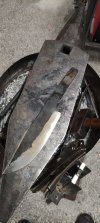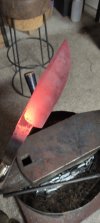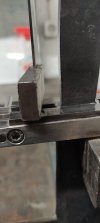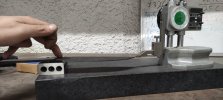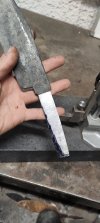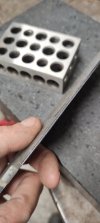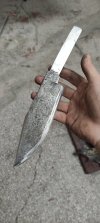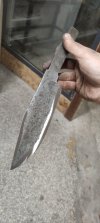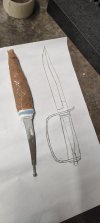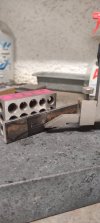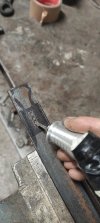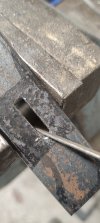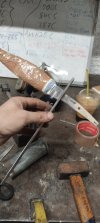I ground the bevels with a jig - I wanted the bevels to be as nice as possible.
I also used a bevel angle calculator, which I do not do often. Recently some people on reddit complained that Dan Comeau's calculator was good and it is gone now (or at best in the internet archive), so I reimplemented it here:
https://respite-engineering.com/flat-grind-bevel-angle-calculator/
Using that I set the angle and went to town.
I tried to take a plunge shot, they are not perfect, but decent enough.
The main bevels were also ground with the jig, and a precalculated angle. The grit progression is something like 40 (to about 75% of bevel height) - 120 (to about 95 %) - A100 (to final height).
Then I went to drill a hole in the end of the tang. I make a scribe line where I want the center line of the hole to be, and then I have this jig where I sandwich the blade, tighten it and there is a guide hole for the drill to not wander (too much). I align the scribe line in the peeking window to make sure it's in the right position. I do not have enough z-height on my mill to drill this standing up.
Still the holes ended up being a little offset to one side, resulting in the threads punching partially through the side. I am fairly certain it's ok, but it could be nicer for sure.
One last shaping operation is rounding of the spine and the bottom. I made this "faceting calculator" for this purpose.
I find that if I mill/machine/chew three facets of a quarter circle at the right distance, then it is a good enough baseline to then simply finish the rounding with a freehand filing and shoe shining with sandpaper.
So here is the layout with two lines on each face and corner. The two lines closest to the corner basically indicate a 45° chamfer, and then I would go half that (by eye) towards the further line. Repeat for all 4 corners.
Not too bad
So here I am after today.
Now the goal is surface refinement before heat treat (I want to go at least 320, preferably more time permitting), and I also want to drill a cross pin hole in the tang to give Tony more possibilities for afixing the handle.
 Tony Mont
has suggested that he and I could do a collaboration for charitable purposes. Of course I jumped on it and we are now on the way! The format is that each of us makes a blade, it will be sent to the other person, who will finish it. After that we will sell/auction it off for charity (the way this will be done or the beneficiaries are yet to be determined at this point).
Tony Mont
has suggested that he and I could do a collaboration for charitable purposes. Of course I jumped on it and we are now on the way! The format is that each of us makes a blade, it will be sent to the other person, who will finish it. After that we will sell/auction it off for charity (the way this will be done or the beneficiaries are yet to be determined at this point).








